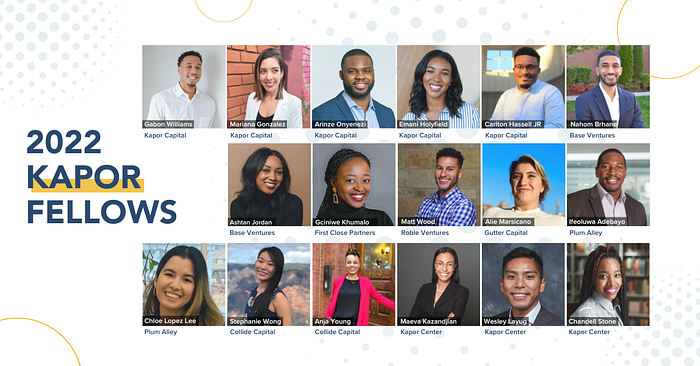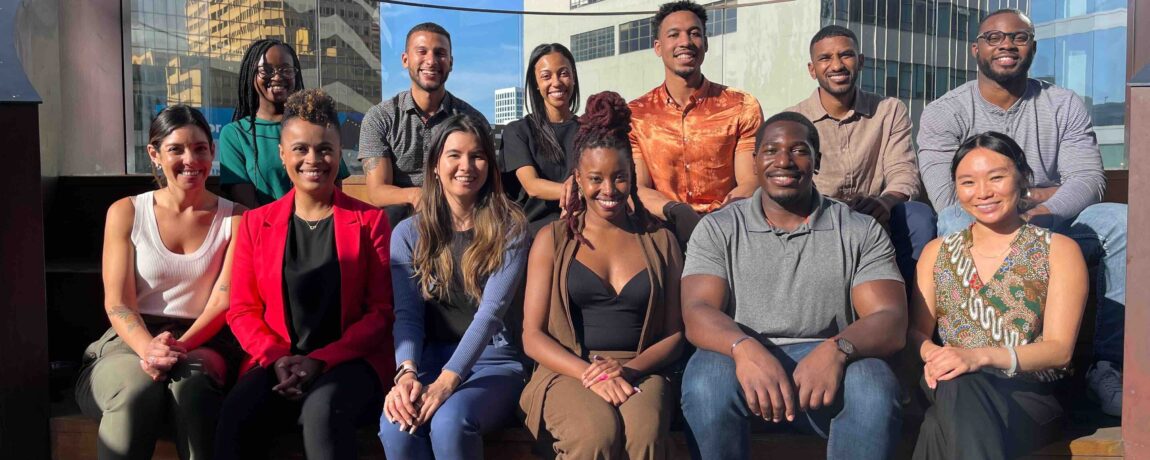In 2022 The Kapor Center launched the Kapor Fellows program to demystify the venture capital industry and provide a pathway for individuals typically underrepresented in venture capital to enter investing. This year, Kapor Center welcomed seventeen amazing individuals to the team for the summer. The 2022 class embodied the Kapor Center’s mission and commitment through their shared belief in each other and social impact-driven startups and technologies. Chandell Stone, a 2022 Kapor Fellow, shares her experience.
Venture Capital is a space that was almost completely unknown to me until last year when my non-profit was accepted into Y-Combinator, an accelerator for early-stage companies. Until then, I had my nose to the ground trying to create change through a lot of grassroots activism and throwing stones at the major philanthropic institutions, hoping that what I was working on fit their grant-making requirements. I was awestruck by how quickly VC funds could deploy large amounts of cash to any idea they thought would disrupt the status quo and/or bring in a return, but underwhelmed by how the faces of folks distributing money didn’t look too different than who’d be sitting on the other end of a foundation call.
Fast forward to a couple of life & career pivots later- I am afforded the opportunity to take a break from coaching founders to learn about investing in gap-closing technologies as a Kapor Fellow. For the first time, I would sit on the other end of an investment decision. As an African- American woman with enslaved ancestry in the antebellum South, opportunities to participate in a powershift are never lost on me. I was eager to dive into the space and come to understand how capitalism in almost its purest form could be leveraged to create a tangible impact in the lives of Black, Brown, and Indigenous people. I was also excited to perhaps leave the days of lengthy grant-writing and slow-moving money behind.

It began with orientation in Oakland. We came together as a group of 17 fellows and 5 or so Kapor Center Team members to get a crash course on topics like valuation methods, networking in Venture Capital, and Impact Investing. Our fellowship cohort became fast friends and an incredibly supportive resource throughout the summer, though we were split up across VC funds in the Bay Area and New York.
The next week I dove head first into looking at deals and doing what Kapor calls “Ecosystem Development”, which I have come to define as engaging, connecting, and funding stakeholders in the Black and Brown tech ecosystem to increase the prevalence of Black-led startups and VC funds. In this Kapor Center bubble of Black (predominantly female) leadership, speaking to Black and Brown fund managers from across the country, working alongside Black and Brown fellows, and investing in Black and Brown communities, one almost forgets what is going on outside. Only 5% of Venture capitalists are Black and Latinx. I liken it to an HBCU experience. And if you are familiar with that experience, you understand how impactful it is in helping circumvent race-related imposter syndrome when it comes to leadership and fields with scarce Black representation. This parallel became increasingly apparent as the fellows and I attended our respective tech hubs’ happy hours and networking events. Each time we were transported back to the other reality and reminded of why what we were doing and what we represented was so important.
But can this fellowship program change the face of VC? And does changing the face of VC even matter in the grand scheme of Black and Brown plight in America?
Well, there are only a few ways that people generally end up being consequential members of the VC community.
- Being a high net worth individual
- Being hired into a fund
- Raising a fund
- Becoming a high-net-worth individual through a company exit
None of us in the fellowship inherited the title of high net worth individual, but there remain 3 other options, all of which by participating in the fellowship have become much more tangible than before we started.
Our introductory experience with VC has increased our likelihood of being hired into a fund. Each of us has built connections that could convert into a Limited Partner or LP (people who invest in funds). And each of us is more adequately prepared to raise capital as a founder because of our experiences as investors. So at scale, a concept not unfamiliar to Kapor, this program could be quite disruptive in an industry with only about 6k American VC funds.
But, does changing the face of VC matter in the grand scheme of Black and Brown plight in America? Capitalism has dealt staggering blows to the Black and Brown community. Why should we divert our attention to spaces (tech & VC) often accused of exacerbating wealth inequality?
The answer is clear. In an industry that is shaping the future of human connection, the need for Black and Brown representation becomes almost existential. Black and Brown founders will continue to be the torchbearers of innovation in our communities. Their pitches must fall on the ears of people who both resonate with their products and are empowered to invest, because investment is often the deciding factor between whether a company scales or dies. Conversely, people who don’t have proximity to our community’s plight are most likely to create innovations that intentionally and unintentionally exclude Black and Brown people in part or whole. Black and Brown investors are generally best equipped to identify exclusionary practices that will impact our communities. And as powerbrokers, they can nurture willing founders into inclusion and can divest from gap-widening endeavors.
So as this summer has come to a close, I feel exceedingly fortunate for the opportunity to be in community with my cohort, the Kapor Center team, many Black fund managers and founders, and Mitch Kapor and Freada Kapor Klein, who continue to be bullish about this radical idea of directing dollars towards Black and Brown innovation and changing the face of VC. And as a descendant of America’s enslaved African community who helped amass its astounding wealth, I am honored to participate in the distribution of its residue into the hands of folks who share their likeness. I look forward to continuing to watch this space closely and positively contribute to the ecosystem as a mentor to founders and an investor in Black, Latinx, and Indigenous innovation.

